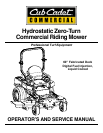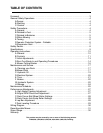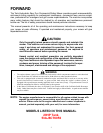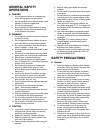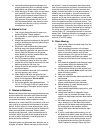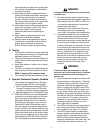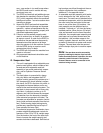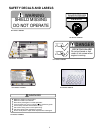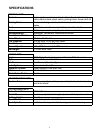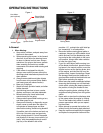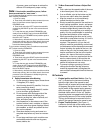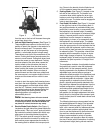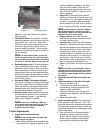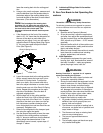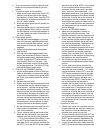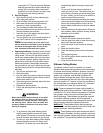5
10. Lead-acid batteries generate hydrogen and
oxygen gases which form an explosive mixture.
Keep sparks and flames away at all times.
11. When looking for oil leaks, never run your hand
over hydraulic hoses, lines or fittings. Never
tighten or adjust hydraulic hoses, lines or fit
-
tings while the system is under pressure. If
high-pressure oil penetrates the skin, the oil
must be removed within a few hours by a doc
-
tor familiar with this form of injury or serious
complications may result.
B. Related to Fuel
1. Fuel is highly flammable and its vapors can
explode if ignited. Please respect it.
2. Do not smoke or permit others to smoke while
handling fuel.
3. Always use approved containers for fuel and fill
slowly to decrease the chance of static electric
-
ity buildup and spillage.
4. Store fuel in well ventilated and unoccupied
buildings away from sparks and flames.
5. When dispensing gasoline into approved con-
tainers, place the container on the ground
when refueling to avoid a possible static elec
-
tricity ignition of fuel vapors.
6. Do not fill containers while it is inside a vehicle,
trunk, the bed of a pickup or floor of a trailer.
7. Always shut off the engine and permit it to cool
before removing the fuel tank cap.
8. Always fill the fuel tank outdoors away from
sparks and flames.
9. If the fuel container spout will not fit inside the
fuel tank opening, use a funnel.
10. When filling the fuel tank, stop when the fuel
reaches one inch from the top. This space is nec
-
essary for fuel expansion.
Do not overfill
.
11. Wipe up any spilled fuel.
12. Do not use gasoline fuel calssified above E-
10 (I.E., E-15 through E-85) as it could cause
severe damage to the engine and fuel system.
C. Related to Batteries
Batteries are stored electrical energy devices that may
be serviceable with removable caps (the electrolyte
levels can be checked), or may be non-serviceable
(no attempt should be made to open the vents).
Batteries may contain lead (Pb) and sulfuric acid, and
they must be re-cycled and not disposed of nor aban
-
doned. Sulfuric acid can cause severe burns, and in
the event of contact, the areas should be flushed with
water and a physician contacted. Battery cases
should not be punctured. Lead is poisonous and is
contained within the positive and negative terminals
as well as within the battery’s internal grid-work of
plates and active materials.
Explosive gases are generated when batteries are re-
charged, so sparks, flames and heat sources should
be avoided. Loose connections at the battery termi
-
nals can produce sprks and heat...connections to the
terminals must be kept tight, and the terminals and
battery surfaces kept clean of acids and corrosion. If
batteries are re-charged or “jumped” from external
sources, make sure that the connections are made
properly and in the correct sequence...connect to the
positive terminal of the good battery first, then connect
that to the positive terminal of the weak battery. The
third connection should be to the negative terminal of
the good battery, followed by the negative terminal of
the weak battery. If sparks are observed or heating of
the wiring or connectors is detected, disconnect in
reverse order (I.E., the negative terminal of the weak
battery first). Batteries should be re-charged at a con
-
stant voltage...generally 14.5 +/- 0.5 volts DC for a
nominal 12 volt DC battery.
D. When Mowing
1. Keep adults, children and pets away from the
area to be mowed.
2. When operating this mower in the forward
direction, DO NOT allow the steering levers to
return to the neutral position on their own.
Always maintain a firm grip on the levers, oper
-
ate them smoothly and avoid any sudden
movements of the levers when starting or stop
-
ping.
3. If the mower is equipped for side discharge, never
use the mower without the discharge chute
installed and placed in the down position.
4. Always remove debris and other objects from
the area to be mowed.(
Note
: debris and loose
grass will reduce traction.)
5. Mow only in daylight.
6. Watch for holes, sprinkler heads and other hid-
den hazards.
7. Avoid driving too close to trees, creeks,
ditches, sand traps and other obstacles.
8. Before backing up, check behind you and
watch where you’re going.
9. Always reduce speed when making a turn, and
when grass is wet.
10. Always mow laterally or diagonally across
slopes, never up and down the slope. Do not
operate on steep slopes and slow down before
turning.
11. Be careful when crossing gravel paths or road-
ways. Always turn off the blade clutch switch
and wait until the blades stop rotating and raise
the cutting deck to the transport position.
Always allow other vehicles to have the right-
of-way.
12. If you hit a solid object while mowing, turn off
the blade clutch switch, place the left and right
steering levers in the neutral position, move the
throttle to slow, set the parking brake, shut off
the engine and take the key from the ignition
switch. Inspect for damage. Repair any dam
-



